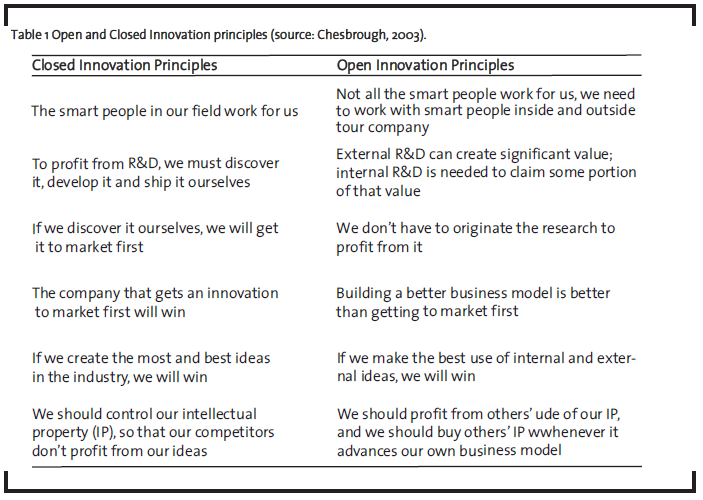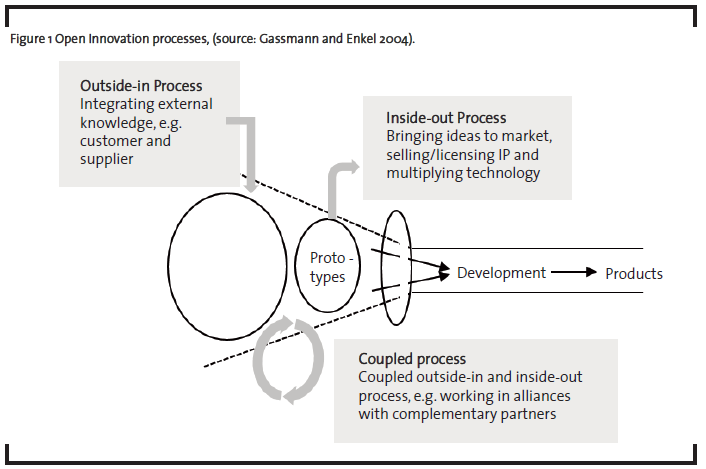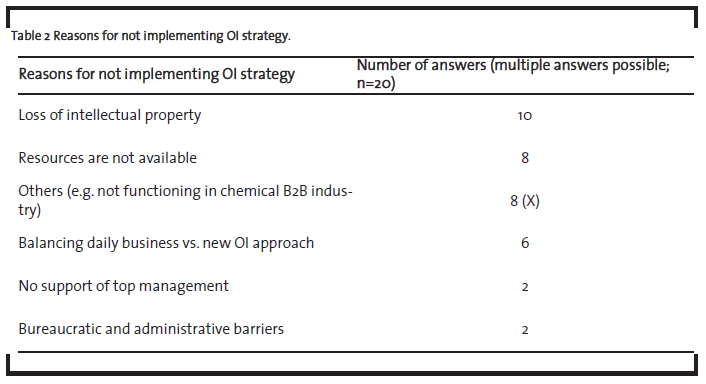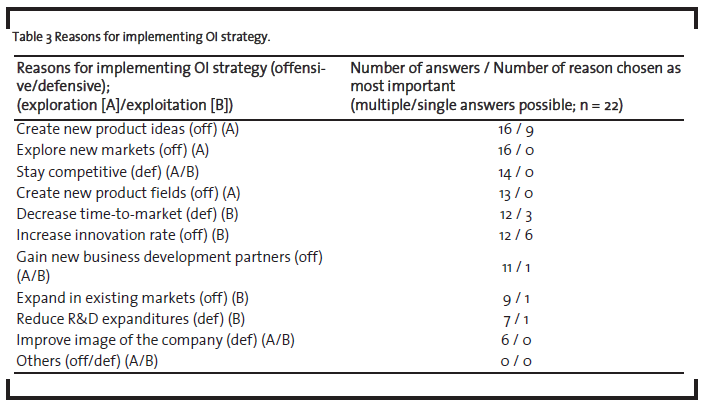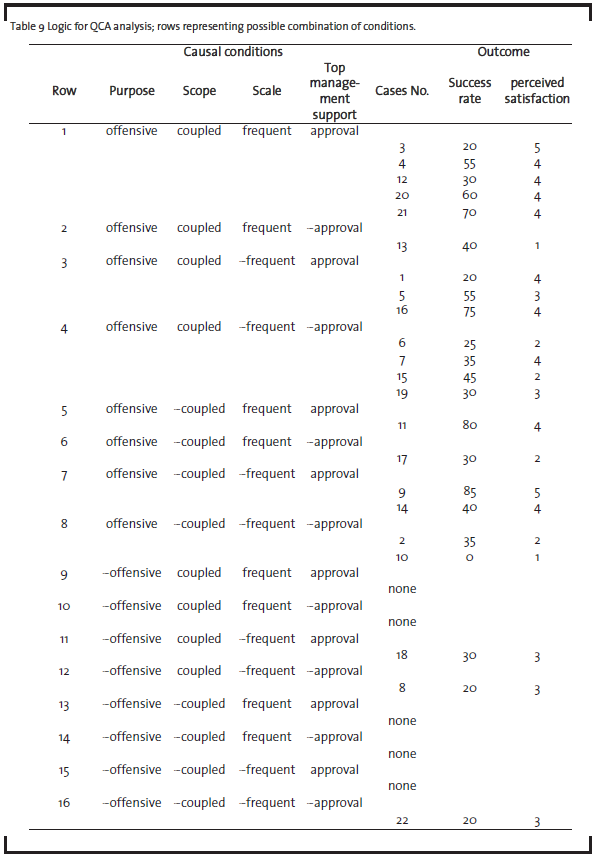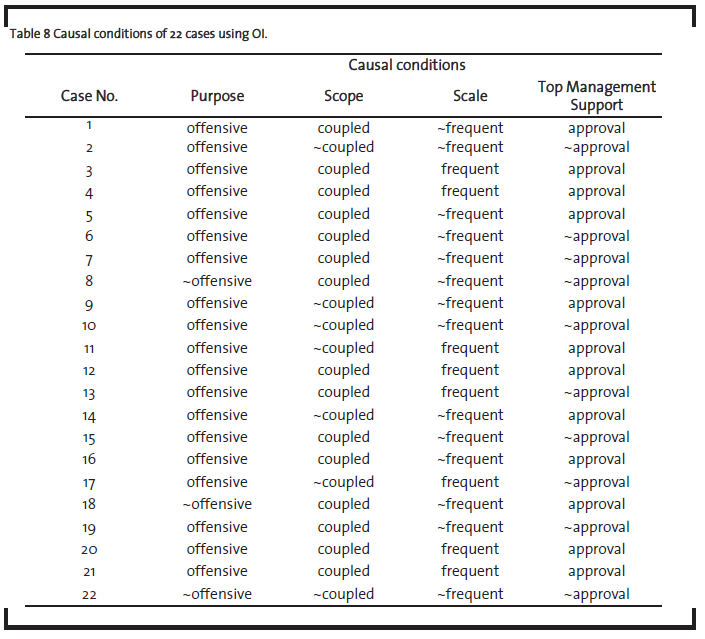Implementation of Open Innovation in Chemical B2B Companies
In a survey-based study including 42 companies of the chemical B2B industry, the usage and dissemination of Open Innovation (OI) initiatives are investigated. The article focuses on strategies and the motivation to implement OI tools. By summarizing the empirical evidence of OI, the success of projects and perceived satisfaction with the chosen approach is assessed using qualitative comparative analysis (QCA). The results show a very diverse picture of OI approaches in the chemical B2B industry, as only 52% of the participants’ state to use OI at all. However, the potential to use OI for exploration and exploitation purposes is revealed, which is especially of interest for a productive and successful implementation. In addition, the need of top management support to successful implement an OI approach is shown.
1 Introduction
Open Innovation (OI) is a major trend in innovation management and is meanwhile widely accepted as a viable approach to cope with current innovation challenges (Chesbrough and Crowther, 2006). Exemplary, increased innovation cycle speed, rising customer expectations or sustainability demands require more flexibility and efficiency in innovation management. Although the willingness to use OI approaches is high, the remaining question is why many companies still rely on the traditional closed innovation approach (Huizingh, 2011). In practice, the difficulties of implementing OI approaches are often explained by the existing boundaries of firms and the failure of management to adequately adjust the organizational setting (Munsch, 2009).
Especially process industries, such as the chemical industry, are confronted with many challenges as their traditional business-to-business models (B2B) are characterized by a high level of secrecy and patenting activity. Consequently, the resulting scale and scope of OI approaches might be different here compared to generally more open industries, like fast developing high tech industries or service providers (Chesbrough and Crowther, 2006). Therefore, to tackle the phenomenon of OI and its still existing shortcomings, it is necessary to look beyond general trends identified across different industries by focusing on the dissemination of OI approaches in traditional B2B-industries, in particular the chemical B2B-industry.
Initially, a literature review on OI is presented in chapter 2. Introducing the general OI concept, the significance of the modern innovation management for the chemical industry with a special focus on the B2B sector is outlined. Chapter 3 presents the focused research objectives. Chapter 4 summarizes the research methodology, which includes the concept of the attached survey and illustrates the empirical analysis on the application and acceptance of OI tools in the chemical industry. Finally, chapter 5 discusses the results, presents the conclusions, reflects on the limitations and offers an outlook on future research.
2 Theoretical Background
2.1 Forms of Open Innovation
The general idea of OI is that organizations are more successful while innovating if they cooperate with external partners to explore, exploit and utilize new ideas to keep up with the market development (Chesbrough, 2003). In this article the definition of West and Gallagher (2006) is used to define Open Innovation. They specified OI as “systematically encouraging and exploring a wide range of internal and external sources for innovation opportunities, consciously integrating that exploration with firm capabilities and resources, and broadly exploiting those opportunities through multiple channels”. The degree of openness remains indeterminate. In table 1 the characteristics of the paradigm change from closed to open innovation are summarized.
To change a firms’ orientation towards an open approach, external stakeholders play a crucial role by leveraging a firm’s investment in internal R&D through the combination of knowledge and capabilities (Fleming, 2002). Consequently, searching for new ideas widely and deeply across a variety of external search channels, e.g. other companies or universities can provide ideas and resources that help firms to explore and exploit opportunities, especially for more radical innovations. Broad and deep OI search, however, comes with a cost. It can be time consuming, expensive, and laborious (Laursen and Salter, 2006). At the same time, further downsides of openness can be resources being available for others to exploit, intellectual property being difficult to protect and resulting benefits from innovations difficult to assign (Dahlander and Gann, 2010).
The scope of implementation can be described by the process itself, comprising the flow of information from the outside and inside of a company (see figure 1, Gassmann and Enkel, 2004). West and Bogers (2014) point out, that even over a decade after Chesbroughs original study, “[…] researchers know very little about why or how often these two activities coexist in one firm, let alone how they are linked within the firm.”
In addition, the successful implementation requires certain tools to operationalize the OI process within companies (Bianchi et al., 2011).
2.2 Open Innovation in Chemical B2B Industry
To use the advantages and overcome the barriers, many different implementation tools for OI approaches have been developed, to integrate the new concept into the organizational structure (e.g. (ICE, 2008)). A recent study showed, that open innovation is most widely adopted in high-tech manufacturing sectors and wholesale, trade and retail (Chesbrough and Brunswicker, 2013).
Many companies in the chemical industry work in the business-to-business (B2B) sector, since the majority of products are intermediates (Albach et al., 1996). Also, the industry is characterized by the heterogeneity of products and the high R&D intensity. The top players in the chemical sector are operating globally, even though they only reached 18% of the total market sales in 2006, which shows that the consolidation level is very low compared e.g. with the automobile or pharmaceutical industry (Hofmann and Budde, 2006). Albach et al.’s (1996) study indicates that before 1993 most innovations in the chemical industry came from inside the company due to a Closed Innovation strategy. In recent years more and more companies therefore see an OI strategy as an opportunity.
Open innovation can be equally exploited by large companies, small- or mid-sized companies and therefore offering chances to all chemical B2B companies. Brunswicker and Vanhaverbeke (2015) showed in their recent study focussing on SMEs, that “[…]engaging in external knowledge sourcing is a sensible move for SMEs as it offers performance benefits and can improve innovation performance in two dimensions, namely the success of launching an innovation and the appropriation of financial value from new products and services”. However, besides single-case studies and multiindustry large number studies also covering chemical companies on a general basis, there is a lack of evidence on the degree of openness in the chemical industry. Likewise, the uncertainty about the strategy of chemical companies – whether the development is towards a more open approach in general or if just a few large enterprises are applying this approach – needs further research.
Another field for further in-depth research is the development of tools and analysis of its usage. In literature the tools are mainly researched by applying case studies close to the end consumer and therefore in less business-to-business orientated settings (Sørensen et al., 2010). Beside those there exists also studies which focus on individual tools, such as e.g. crowd sourcing (Zhu et al., 2016) or special forms of collaboration, such as e.g. university- industry collaboration (Niedergassel and Leker, 2009).
3 Research objectives
To derive a better picture on the value and status of usage of open innovation approaches in chemical B2B industry, a specific assessment of current practices is key. As Tucci et al. (2016) point out, especially the tools used for implementation (e.g. for usage of crowdsourcing) and the scope of OI (i.e. exploration vs. exploitation) are major areas of interest for decision makers in industry and scholars alike (Tucci et al. 2016).
Therefore, it shall be investigated to what degree open innovation is used and what forms of open innovation tools serve best to be implemented in the special setting of process industry companies, such as chemical B2B firms.
Consequently, the following research questions are investigated in this explorative study:
- What are the reasons for the use or not-use of OI approaches in chemical B2B industry?
- What is the scale and scope of the OI approach used in the chemical B2B industry?
- Can patterns in strategic implementation be detected that explain the satisfaction with and success of the use of OI approaches?
4 Research design and results
4.1 Research design and data sources
A list of common tools for implementation of OI in management practice, such as institutional research activities, OI competitions, workshops, strategic alliances, publicly funded projects, technology scouts, patent research, ethnography, customer visit teams and lead users are identified from meta-analysis and expert interviews with 4 executive innovation managers in the chemical B2B industry (see Appendix, table 7).
Based on the initial results from the expert interviews and the additional consideration, a structured online survey is developed to answer the research questions (see section 3).
First addressing research question 1 – the reasons for and against the implementation of OI methods as well as prejudices in business practice, are assessed through a combination of pre-defined answers and open choice items. The second section addresses research question 2 and asks for the scale and scope of OI approaches and tools used. Therefore, the dissemination (open or closed innovation approach), the motives (offensive or defensive), the underlying process as scope (inside-out, outside-in or coupled process), and the scale of usage (number of OI projects in past 5 years) are investigated. The third part of the questionnaire asks for the outcomes of the use of OI tools in business practice and the degree to which expectations have been fulfilled. Therefore, directed questions and scale items using perceived satisfaction were utilized. This knowledge can be used to provide an answer to research question 3 – the strategic fit of specific tools to reasons for OI use.
In addition, firm parameters (e.g. size, relative R&D budget), position of the participant in the company, top management support in implementing OI and experience of the survey participant in the firm are taken as moderating variables and allow controlling for possible biases within the survey.
The structured online survey was send via email to innovation managers (4 answers), R&D managers (22 answers), chief executive officers (3 answers) and others (e.g. technical sales managers; technical marketing) (13 answers) in the chemical B2B industry in Western European countries. Out of 147 companies contacted per telephone 42 (29%) completed the online-questionnaire, using telephone calls as reminder.
The potential problems inherent in an onlinesurvey make the analysis of position of the respondents and non-respondents a crucial exercise. A ttest comparing early respondents (first one-third) against late respondents (last one-third) is performed in order to check for non-response bias (Armstrong, and Overton, 1977). A special focus is set on the usage of an OI approach, since the possible bias is seen strongest in this aspect, since the survey was proclaimed as a survey on OI usage in the chemical B2B industry.
For further investigation of the strategic fit of different management strategies and aims of OI usage, the answers are analyzed for patterns concerning motives, chosen OI approach in scale and scope, and top management support using qualitative comparative analysis (QCA) (Ragin, 1994; Ragin, 1998; Schneider and Wagemann, 2010). The structured groups of companies are then analyzed for patterns in success rate of OI projects and perceived satisfaction of the respondent with the implemented OI approach. Even though this is a comparable subjective measure, it gives valuable insights on the usage of OI approaches in a company and gives a more complex answer to the functionality of OI in the chemical B2B industry.
In contrast to statistical methodology, QCA is based on Boolean algebra and treats cases in terms of their multiple memberships in sets (Ragin, 1994; Ragin, 1998). This allows viewing a single case according to his multiple memberships in multiple dichotome (“crisp”) sets, viewed as configuration. The underlying interest now is how different sets combine in each case to give a rationale for resulting mechanisms (Ragin, 1998).
The selection of causal conditions is quite broad to capture factors that connect to the outcomes as well as conditions that provide context for the operation of these factors (Schneider and Wagemann, 2010). Therefore, the underlying purposes for implementing an OI strategy, the scope of the implemented OI strategy, the frequency of usage (scale) and the moderating top management support as a context providing parameter are considered as possible sets with dichotome causal conditions for the cases using an OI strategy.
4.2 Reasons for not implementing OI
In the responding companies of the chemical B2B industry the usage of OI approaches is quite divers. Only 52% (22 of 42) of the respondents’ state that their companies use (at least partially) an OI approach, resulting in 48% (20 of 42) of companies still following a closed innovation process.
The reasons for not implementing are partly based on the high sensitivity for secrecy in the chemical industry. 50% of respondents not using OI see the loss of intellectual property as a main reason for not engaging in a more open process (see table 2). This may be due to the fact, that chemical companies’ competitive advantage is based on process innovations, which are hard to protect by patents. Another major reason is the perceived lack of resources, which is named by 40% of the respondents as a reason for not using an OI approach. This statement in combination with 25% of companies expressing their concerns about the usability of OI in the chemical B2B industry exposes still existing doubts about the applicability and possible advantages in this industry. The reason for this impression of OI, which is contradictory to the 52% of companies actively using OI, are not further investigated. Perhaps there is a difference in customer structure, internal organization or simply in managers’ personal belief in charge of innovation processes.
4.3 Motivation to use OI in chemical B2B companies
In contrast to the findings from chapter 4.2 22 companies actively use OI. To study the implementation of open innovation according to Huizingh (2011) the reasons why firms open up their innovation processes are investigated. Huizingh (2011) defines: “[…] one distinction is for offensive motives (e.g. stimulating growth) or for defensive motives (e.g., decreasing costs and risks)”. In the given sample, firms using OI mainly focus on offensive motives as creating new product ideas or exploring new markets (see table 3). Just a few aim at defensive motives to stay competitive (combined with decreasing their time to market or reducing their R&D expenditures). However, in most cases there is a combination of defensive and offensive motives. Just 3 companies use OI for purely defensive motives.
There is also a clear trend, that OI is seen as a tool for exploration1 (e.g. create new product ideas, create new product fields) as well as for exploitation (decrease time-to-market, increase innovation rate, reducing R&D expenditures) within the chemical B2B industry. This finding is highly interesting as it shows that the full potential is visible and actively fostered by innovation managers across the industry. Especially the reasons aiming at an exploitation of innovation capabilities are often seen as most important (10 of 22 cases).
1Cohen and Levinthal (1989) define the activities exploitation and exploration as the two sides of R&D: innovation and learning. These two different activities not only imply different organisational designs, but also differ in the underlying innovation processes.
4.4 Scale and scope of OI processes
The 22 companies who state to use an OI approach all try to internalize external knowledge, representing the outside-in process. 15 of the companies also say they try to use the inside-out process to externalize ideas, in example if research projects cannot be continued internally without external support, representing the coupled process (see table 4).
It is further shown that, even though 68% of firms say they use a coupled process, a majority of these firms clearly focuses on internalizing existing ideas from the external world rather than to give ideas created in-house to potential competitors. This is reflected by the major use of OI tools that aim at exploration of ideas and exploitation of new knowledge, rather than utilization of ideas and innovations by out-licensing or publishing of results. The major tools for incorporating knowledge are expert workshops, patent analysis and customer visit teams (see table 5). Regularly used concepts by other industries as innovation challenges for end-consumers (e.g. using social media or the own website (Slowinski et al., 2009)) are rather rare. The main outflow of ideas and knowledge (as described by the inside-out-process) is done in joint-development projects (63%) and institutional research projects (50%). However, some companies seem to make good experiences with this approach, as 8 respondents say these are the most important OI tools for their company.
Table 6 shows the usage of OI tools in projects conducted within the last 5 years by the investigated companies. The most chemical companies who frequently (more than 10 projects) use OI are large companies. Nevertheless, 11-20 projects is a rather small number in 5 years compared to their total research projects’ volume, suggesting that only 23% of the large companies pursuing an OI approach do it with high intensity. Surprisingly, two OI champions (40%) belonging to the group of SME seem to do OI on a regular basis. However, it is shown that in most of the companies the number of projects actively using OI tools is rather limited.
Asked for their future expectations of OI in the chemical B2B industry, 16 of 22 respondents see an increase in importance. 5 of 22 do not see a major change towards OI and only one respondent expects a decrease of importance of OI in this business field.
4.5 Qualitative comparative analysis
In total, innovation managers who use OI tools are quite diverse in their opinion about the outcomes, as a quite big group of still sceptical respondents (50%) does not see a positive or even see negative effects of applying OI tools (see Appendix, table 8). Therefore, the success rates and perceived satisfaction is matched over qualitative comparative analysis (QCA) with the previous findings.
The t-test showed no significant difference in response behavior between early and late respondents. Therefore, a respondent bias is not further considered.
The purpose of the implementation of an OI approach can be done either to offensive or defensive reasons. To form a crisp set, offensive reasons are positive, if at least one of the reasons create new product ideas, explore new markets, create new product fields, increase innovation rate, gain new business development partners or expand in existing markets is named (see Appendix, table 3, table 8), others are marked as non-offensive purpose (~offensive). Further the scope is defined as coupled process for companies using both approaches and non-coupled (~coupled) for companies using just one way of open interaction. While there are no companies in the sample using solely the insideout process, ~coupled equals outside-in process. The scale of usage is defined as frequent usage, if more than 10 OI projects have been carried out within the last 5 years, resulting in non-frequent usage (~frequent) of companies with 10 or less conducted projects using OI tools. The moderating variable top management support is set positive for strong and medium support and set to non-support (~approval) for values representing neutral attitude of top management or even rejection (see Appendix, table 8).
The dependent variables considered are perceived satisfaction, measured on a 5-point scale (1 – very unsatisfied to 5 – very satisfied), and success rate of OI projects in past 5 years, measured in percentage of overall OI projects.
These variables are used to construct a “property space” that constitutes all potential locations as a different kind of type (Lazarsfeld, 1937). To construct this table listing the possible logically combinations of configurations together with the cases comprising the respective configuration (see Appendix, table 9), the factors have to be split in dichotome sets (Ragin, 1998).
Each row of table 9 (see Appendix) with the assigned cases is afterwards examined on whether the outcomes show substantial differences to get confidence that a viable specification of causal conditions is realized (Ragin, 1998). As all cases within one row do not display widely divergent outcomes the specification of causal conditions can be used for further analysis. Naturally, not all theoretically possible cases appear in practice, because some combinations of factors induce a greater likelihood of specific shaping of corresponding factors (e.g. defensive use intention without top management support will probably not result in a very frequent usage).
The analysis shows that most cases are in sets having offensive motives as an underlying rational to implement OI, which is in line with the findings in chapter 4.3. However, success rates as well as the perceived satisfaction of involved managers differ widely between these groups.
Analysis using a strict assessment2 for sufficiency of conditions following Ragin (1998) in combination with Schneider and Wagemann (2010), shows that high perceived satisfaction results from offensive purposes combined (* representing logical AND) with top management support:
Positive perceived satisfaction = offensive*approval
The success rate cannot be matched to a single combination of causal conditions. This can be due to the natural risk of projects, which can result in strong fluctuation of the success rate in the sample size given. However, the suspected effect of frequent usage of OI tools does not show an increasing effect on success rates. It is striking, that the frequent as well as the not frequent use of an outside-in process for offensive purposes in combination with top management support (see Appendix, table 9, rows 5 and 7) show above average success rates and high perceived satisfaction (statistically significant one-tailed significance level of 5%).
High success rate = offensive*~coupled*approval
However, this result is to be handled with care due to the fact that just 3 of the 22 cases belong to these rows. Still, it is unrealistic to expect that all cases in a row display the same outcomes, as only some very broad factors are considered and it is very difficult in such a small sample to capture all causally relevant conditions in such a cross-case analysis (Ragin, 1998). At the same time different additional conditions can further contribute to outcomes, even if they are not present in the first analysis. As other cases also show high success rates with different combinations of causal conditions, the equation for high success rate (+ representing logical OR) has to be extended to:
High success rate = offensive*~coupled*approval+combination with unknown conditions
Further, it is highly interesting that in two cases a coupled process is used for solely defensive purposes on a non-frequent basis.
2A strict assessment implies no allowance for discordant outcomes among the cases conforming to a causal combination to confirm the sufficiency assessment of a causal combination. The probabilistic approach, which also tolerates outliers, needs a larger sample size or at least a higher number of cases in each row to be applicable.
5 Conclusions
The results presented in chapter 4 show a very divergent picture of the chemical B2B industry concerning the use of OI approaches. Many companies in the industry are still sceptical about the use of OI while about half of the companies make a decision against implementing an OI approach. The main reason for this is still the fear of losing relevant intellectual property to competitors. This is especially relevant for the B2B chemical industry, as many value drivers are specialized knowledge not openly accessible or highly exploited production processes. A very transparent innovation process can result in a loss of relevant value drivers to competitors as well. Furthermore the big efforts to protect intellectual property in an OI process may result in slow and complex processes as well as mistrust among the all involved.
However, as innovation cycle times decrease, also traditional industries such as the chemical B2B industry start to open up their innovation processes in large companies (Mortara and Minshall, 2011) and also in SMEs (Narula 2004). This holds true in this sample of chemical B2B companies. The motives to use OI approaches are shown to be growth rather than cost savings. However, exploration does not prevail as exploitation of innovation processes and existing products is often named as the most important reason for a usage of OI. Still, the dissemination and frequency of usage is not as high as it is in prominent case samples closer to the end consumer.
While many large companies try to use OI as an approach to further develop their innovation processes, some small companies reveal the possibility to use accessible external resources for their products. Analyzing the commonly used tools like customer visit teams, patent analysis and workshops, shows that companies mainly try to internalize external knowledge and ideas, even though the majority says of themselves to use a coupled OI process. The companies actively opening up in both ways do this by participating in joint research and development projects either with industry partners or in publicly funded projects with academic partners. The experiences from these approaches seem promising, as many companies active in these collaborations see them as their most important OI tool. A possible reason for this selection of tools might be based in the higher contractual security of intellectual property, which is fixed in advance of the collaboration. Further, from an innovators point of view it might be easier to open up and let out knowledge and ideas, if the setting was mutual with other innovators. In explicit a setting in which the counterpart is able and willing to share knowledge, too, as in the described joint research and development projects or publicly funded projects in collaboration with academic institutions.
Furthermore the design and practical configuration of innovation approaches in chemical B2B companies are linked to their perceived satisfaction with their OI approach and given innovation results. Unsurprisingly, the perceived satisfaction is greatest, if offensive motives are the reason to use OI and the needed resources to advance with the OI approach in forms of financing and time for the implementing manager (expressed through top management support) is given to support the activities and fosters the approach to open up.
However, the usage of a pure outside-in process seems also promising in some companies. For these one-sided approaches long term contemplation with special regards to their future development would be of highest interest. No distinction whether permanent or single project approaches positively influence success rate or satisfaction is found. This raises the question whether the explanation can be found in differences of firm characteristics or whether a more frequent use despite this finding usually eases the use of OI tools and companies are just not ready to do so now.
Therefore, the following implications can be given to innovation managers willing to implement an OI strategy in a process B2B company:
1) Clearly define the goals and motives for the use of OI. Make sure the goals do not contradict each other and are achievable.
2) Select which information you are willing to share and what information you want to gain by using an OI strategy (degree of openness). Define which function in the company is in charge and whether the strategy is aiming at exploration or exploitation activities. Keep in mind that exploiting production processes using OI requires highly specialized external resources and often implies deep insights for external into internal procedures and processes.
3) Develop and align existing tools (a selection can be found in this article) to your strategic purposes and identified needs. Keep in mind that tools developed for large customer bases with little understanding of the product might not work for the purposes in highly specialized B2B products. Depending on the tool/activities: Search for possible OI partners, providing the knowledge and resources you need. Clearly define the risks (ideas, patents, products, processes, image of the company, etc.) resulting from the usage of tools and interaction with partners and possible countermeasures upfront.
4) Assess the resources and time needed to implement the activities resulting from your OI strategy (internal and external), from the usage of specific tools and also from the planed countermeasures (e.g. to protect intellectual property in OI projects).
5) Make sure to have top management support (including the financing, manpower and infrastructure) and the support of key players in the process. Think of the reaction of top management and key players, if implementation is behind schedule out of external reasons and possible solutions.
References
Albach, H., Audretsch, D.B., Fleischer, M., Greb, R., Höfs, E., Röller, L. and Schulz,I. (1996): Innovation in the European chemical industry, WZB Discussion Paper, FS IV 96-26, pp. 1-130.
Armstrong, J.S. and Overton, T.S. (1977): Estimating nonresponse bias in mail surveys. Journal of Marketing Research (JMR), 14(3),396-402.
Bianchi, M., Cavaliere, A., Chiaroni, D., Frattini, F. and Chiesa, V. (2011): Organisational modes for Open Innovation in the bio-pharmaceutical industry: An exploratory analysis. Technovation, 31(1), pp. 22-33.
Brunswicker, S. and Vanhaverbeke, W. (2015): Open innovation in small and medium‐sized enterprises (SMEs): External knowledge sourcing strategies and internal organizational facilitators. Journal of Small Business Management, 53(4), pp. 1241-1263.
Chesbrough, H.W. (2003): Open innovation: The new imperative for creating and profiting from technology. Harvard Business Press.
Chesbrough, H. and Brunswicker S. (2013):Managing open innovation in large firms. Fraunhofer Verlag Berkeley, CA.
Cohen, W.M. and Levinthal, D.A. (1989): Innovation and learning: the two faces of R & D. The economic journal, pp. 569-596.
Cooper, R.G and Edgett, S. (2008): Ideation for product innovation: What are the best methods. PDMA visions magazine, 1(1), pp. 12-17.
Dahlander, L. and Gann, D. (2010): How open is innovation? Research policy, 39(6), pp. 699-709.
Ertl, M. (2012): Strategische Voraussetzungen für ein erfolgreiches Open-Innovation-Konzept. DIFI-Tagung 2012: Erfolge mit Open Innovation – neuere Erkenntnisse und Entwicklungen, Geschka & Partner Unternehmensberatung, Darmstadt, .
Fleming, L. (2002): Recombinant uncertainty in technological search. Management science, 47(1), pp. 117-132.
Gassmann, O. and Enkel, E. (2004): Towards a Theory of Open Innovation: Three Core Process Archetypes. R&D Management Conference (RADMA). – Lisabon, Portugal., pp. 1-18.
Gulati, R. (1998): Alliances and networks. Strategic Management Journal, 19(4), pp. 293-317.
Herzog, P. and Leker, J. (2010): Open and closed innovation–different innovation cultures for different strategies. International Journal of Technology Management, 52(3), pp. 322-343.
Hofmann, K. and Budde;f. (2006): Today’s Chemical Industry: Which way is up? Value creation: strategies for the chemical industry. Budde, F.; Felcht, U.; Frankemöller, H., pp. 1-10.
Huizingh, E.K.R.E. (2011): Open innovation: State of the art and future perspectives. Technovation, 31(1), pp. 2-9.
ICE, 2008-last update, When the customer encounters the employee-Interactive userbased innovation in service, available at http://iceproject.dk/downloads/Description%20project.pdf, accessed 23 December 2013.
Laursen, K. and Salter, S. (2006): Open for innovation: the role of openness in explaining innovation performance among U.K. manufacturing firms. Strategic Management Journal, 27(2), pp. 131-150.
Lazarsfeld, P. (1937): Some remarks on the typological Procedures in Social Research. Zeitschrift für Sozialforschung, Vi, pp. 119-139.
McQuarrie, E.F. (2008): Customer visits: Building a better market focus. ME Sharpe.
Mortara, L. and Minshall, T. (2011): How do large multinational companies implement open innovation? Technovation, 31(10), pp. 586-597.
Munsch, K. (2009): Open model innovation: Culture, contract and competition embrace the practical issues that R&D leaders need to consider. Research Technology Management, 52(3), pp. 48-52.
Narula, R. (2004): R&D collaboration by SMEs: new opportunities and limitations in the face of globalisation. Technovation, 24(2), pp. 153-161.
Niedergassel, B. and Leker, J. (2009): Open innovation: chances and challenges for the pharmaceutical industry. Future medicinal chemistry, 1(7), pp. 1197-1200.
Perkmann, M. and Walsh, K. (2007): Universityindustry relationships and open innovation: Towards a research agenda. International Journal of Management Reviews, 9(4), pp. 259-280.
Ragin, C.C. (1998): The logic of qualitative comparative analysis. International review of social history, 43(S6), pp. 105-124.
Ragin, C.C. (1994): Introduction to qualitative comparative analysis. The comparative political economy of the welfare state, 299, pp. 300-309.
Rohrbeck, R. (2007): Technology Scouting–a case study on the Deutsche Telekom Laboratories.
Saxenian, A. (1996): Inside-out: regional networks and industrial adaptation in Silicon Valley and Route 128. Cityscape, pp. 41-60.
Schneider, C.Q. and Wagemann, C. (2010): Standards of good practice in qualitative comparative analysis (QCA) and fuzzy-sets. Comparative Sociology, 9(3), pp. 397-418.
Schroll, A. and Römer, S. (2011): Open Innovation heute: Instrumente und Erfolgsfaktoren. Information Management und Consulting (IM), imc information multimedia communication AG, Saarbrücken, Ausg, 1(2011), pp. 58-63.
Shohet, S. (2008): Using technology scouting as part of Open Innovation. Cambridge: Sagentia Ldt.
Simard, C. and West, J. (2006): Knowledge networks and the geographic locus of innovation. In: O. OXFORD UNIVERSITY PRESS, ed, Open Innovation: Researching a new paradigm. Chesbrough, H., Vanhaverbeke, W., West, J., .
Slowinski, G., Hummel, E., Gupta, A. and Gilmont, E.R. (2009): Effective practices for sourcing innovation. Research-Technology Management, 52(1), pp. 27-34.
Sørensen, F., Mattsson, J. and Sundbo, J. (2010): Experimental methods in innovation research. Research policy, 39(3), pp. 313-322.
Sousa, M. (2008): Open innovation models and the role of knowledge brokers. Inside Knowledge, 11(6), pp. 18-22.
Tucci, C.L., Chesbrough, H., Piller, F.,and West, J. (2016): When do firms undertake open, collaborative activities? Introduction to the special section on open innovation and open business models. Industrial and Corporate Change, 25(2), pp. 283-288.
Vom Stein, N., Sick, N., Leker, J. (2013): How to measure technological distance in collaborations? The case of electric mobility. Technological Forecasting and Social Change, 97, pp. 154-167.
Von Hippel, E. (1988): The sources of innovation. New York: Oxford University Press. West, J. and Bogers, M. (2014): Leveraging external sources of innovation: a review of research on open innovation. Journal of Product Innovation Management, 31(4), pp. 814-831.
West, J. and Gallagher, S. (2006): Challenges of open innovation: the paradox of firm investment in open‐source software. R&D Management, 36(3), pp. 319-331.
Zhu, H., Sick, N. and Leker, J. (2016): How to use crowdsourcing for innovation?: A comparative case study of internal and external idea sourcing in the chemical industry, Management of Engineering and Technology (PICMET), 2016 Portland International Conference on 2016, IEEE, pp. 887-901.
Appendix
